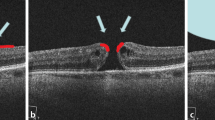Abstract
We describe a highly viscous fluid inside the macular hole and document that disappearance of this viscous fluid results in concentric macular hole closure. Twenty eyes of 20 patients (64.9 ± 6.9, 54–73 years) with macular holes who underwent 25-gauge (25G) transconjunctival vitrectomy were studied. Macular holes were Gass stage 2 in 4 eyes, stage 3 in 11, and stage 4 in 5. After peeling the internal limiting membrane around the macular hole, fluid was aspirated from the edge of the macular hole using a 25G soft tip cannula while performing fluid-air replacement. During aspiration, a highly viscous fluid was observed in all cases irrespective of stage. After several aspirations of this viscous fluid, the fluid cuff flattened and the macular hole closed in a concentric manner. The viscous fluid showed the “sticky sign” resembling the thread formation of melted cheese. After replacing the vitreous with octafluoropropane and keeping the patient in a prone position for 1 day, the macular hole showed full closure in all cases. Disappearance of subretinal viscous fluid accompanied by flattening and concentric displacement of the fluid cuff is associated with closure of macular hole.


Similar content being viewed by others
References
Kelly NE, Wendel RT (1991) Vitreous surgery for idiopathic macular holes. Results of a pilot study. Arch Ophthalmol 109:654–659
Gass JD (1988) Idiopathic senile macular hole. Its early stages and pathogenesis. Arch Ophthalmol 106:629–639
Gass JD (1995) Reappraisal of biomicroscopic classification of stages of development of a macular hole. Am J Ophthalmol 119:752–759
Guillaubey A, Malvitte L, Lafontaine PO et al (2008) Comparison of face-down and seated position after idiopathic macular hole surgery: a randomized clinical trial. Am J Ophthalmol 146:128–134
Jensen OM, Larsen M (1998) Objective assessment of photoreceptor displacement and metamorphopsia: a study of macular holes. Arch Ophthalmol 116:1303–1306
Saito Y, Hirata Y, Hayashi A et al (2000) The visual performance and metamorphopsia of patients with macular holes. Arch Ophthalmol 118:41–46
Enaida H, Hisatomi T, Hata Y et al (2006) Brilliant blue G selectively stains the internal limiting membrane/brilliant blue G-assisted membrane peeling. Retina 26:631–636
Acknowledgment
This study was financed regular departmental research funds. No financial or material support was received from other sources.
Author information
Authors and Affiliations
Corresponding author
Rights and permissions
About this article
Cite this article
Shimada, H., Hattori, T., Nakashizuka, H. et al. Highly viscous fluid in macular holes. Int Ophthalmol 30, 319–321 (2010). https://doi.org/10.1007/s10792-009-9321-z
Received:
Accepted:
Published:
Issue Date:
DOI: https://doi.org/10.1007/s10792-009-9321-z




